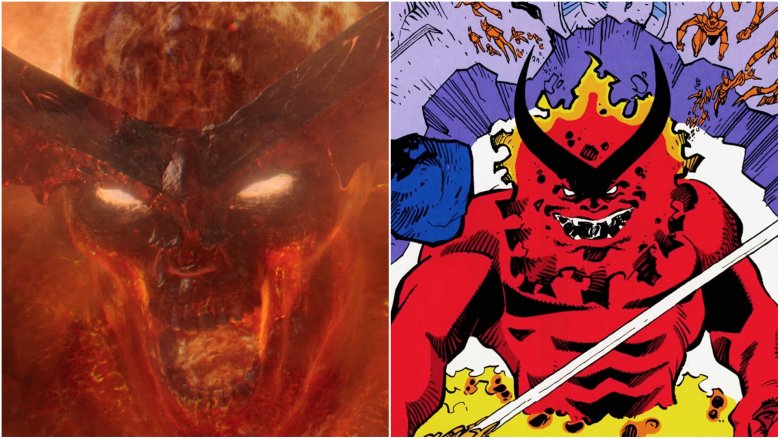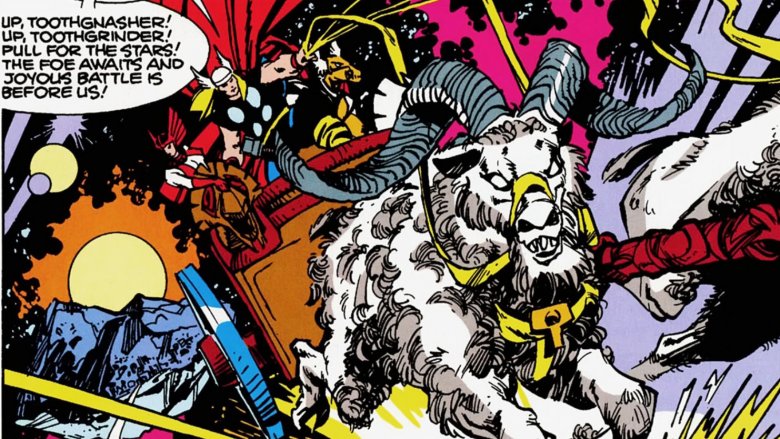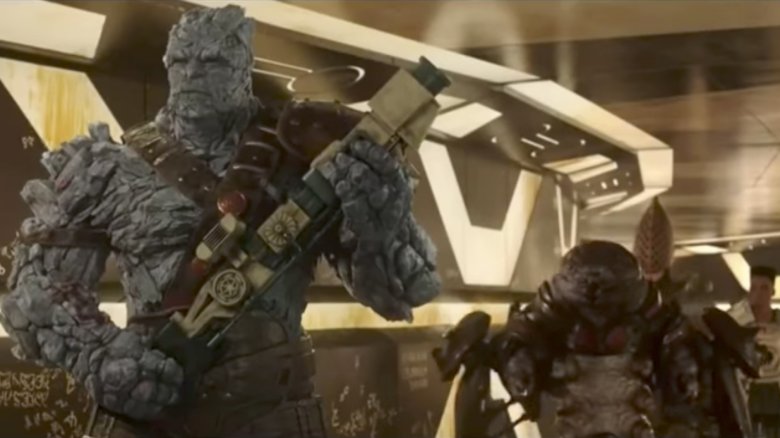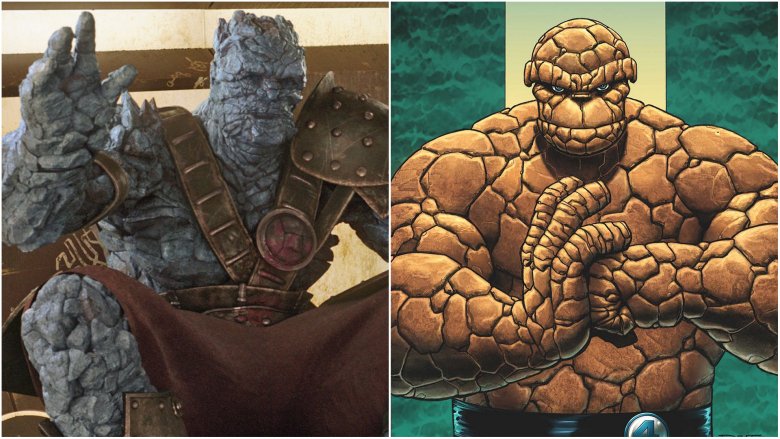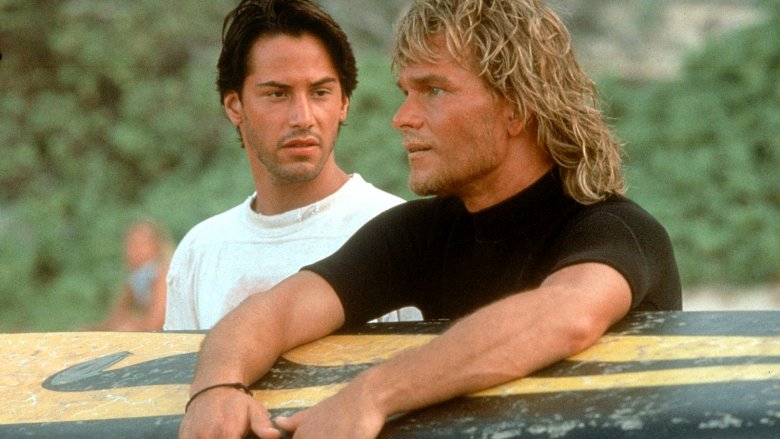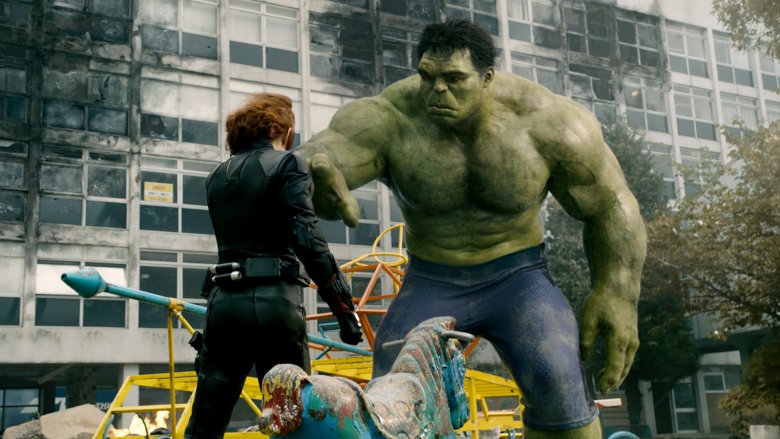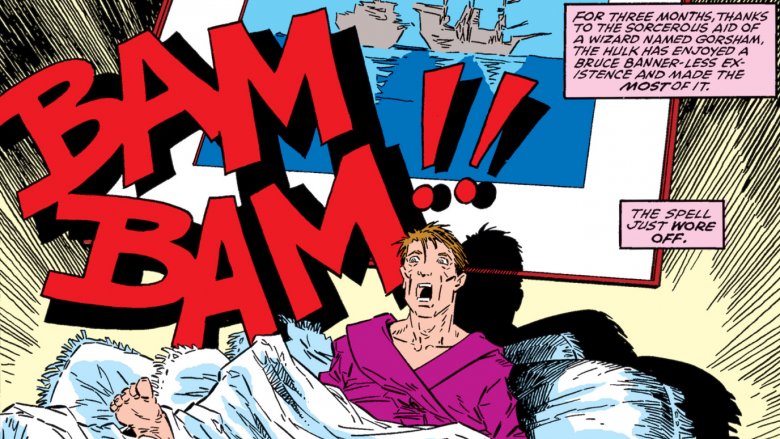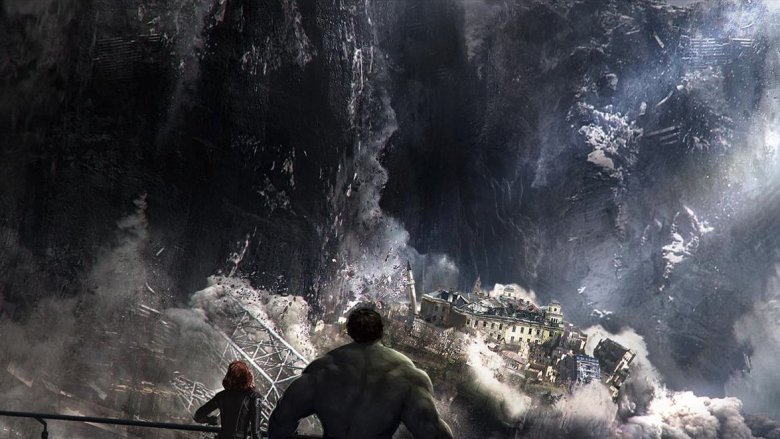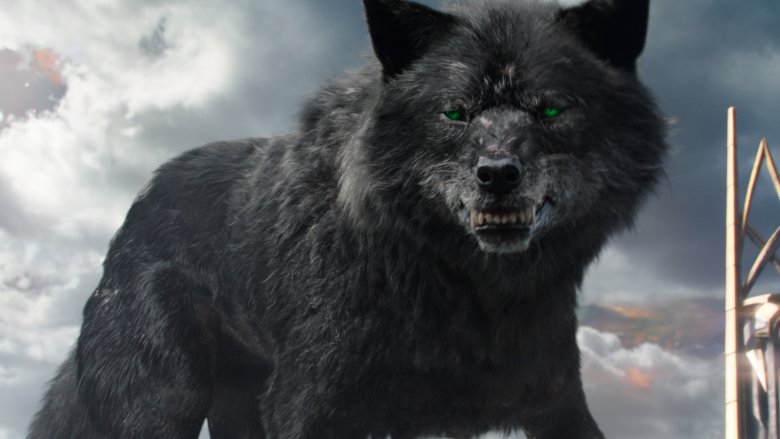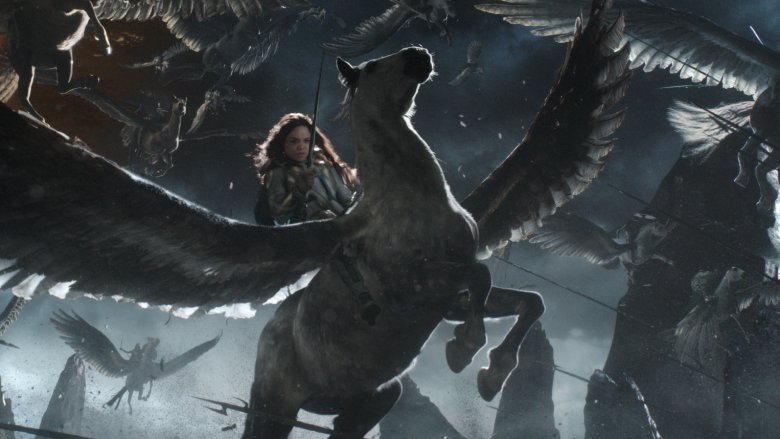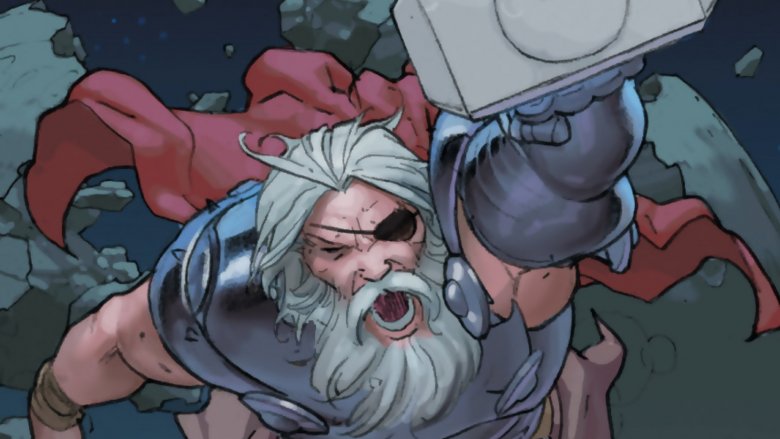Small Details In Thor: Ragnarok Only True Fans Understood
You don't have to read comics to love Thor: Ragnarok, because director Taika Waititi and crew have made such a genuinely fun movie, but for longtime Marvel Comics fans, it's somehow even more special. While Ragnarok tells a great story that stands on its own, it's also chock full of references to Marvel lore—the movies as well as the comics. And even better, none of them feel cheap.
Knowing the sources of the various references and jokes adds further color to the story and characters of the movie. With that in mind, here are some of the references in Thor: Ragnarok that you might have missed.
Immigrant Song
Led Zeppelin's "Immigrant Song" is the perfect music to accompany a high-octane action sequence like the ones at the beginning and end of Thor: Ragnarok. Robert plant's distinctive wail really sticks with you in a good way—but if you pay attention, you realize its lyrics fit perfectly too. Plant and Jimmy Page wrote the song after visiting Iceland and being impressed with its landscape and history, and the song's full of references to the same Scandinavian mythology upon which the Thor comics were based:
We come from the land of the ice and snow
From the midnight sun, where the hot springs flow
The hammer of the gods
We'll drive our ships to new lands
To fight the horde, and sing and cry
Valhalla, I am coming!
"The hammer of the gods" is a reference to Thor's hammer Mjölnir, which Hela shatters early in the film. The "drive our ship to new lands" bit was written about Viking raiders, but it also perfectly describes the situation of the Asgardians at the end of Thor: Ragnarok. And of course Valhalla is the realm of the honored dead who died gloriously in battle. The Norse afterlife is left out of the Thor movies, but clearly after the events of this one, Valhalla would be crowded with Asgardians.
Surtur's eyebrow crown
In the movie, Surtur (Clancy Brown) can only rise to his full power and ignite Ragnarok by placing his crown (which is a part of his skull) in the Eternal Flame, which is kept in the vault of Odin's palace. In the Walt Simonson Thor comics, it's actually Surtur's sword, Twilight, that he must place in the Flame—but it's so huge, it would barely fit in the film version of the vault. Plus, making it Surtur's skull enables the ending of the movie to work in a way it wouldn't if only his sword had been brought to the palace.
But the focus on his crown is also a metatextual joke. Aside from being a giant of living fire, there's not much that visually unites the movie version of Surtur with the character as he appears in Simonson's comics. Movie Surtur is thinner and more human-shaped, and his head has a definably shaped skull, whereas comics Surtur's head is a shapeless ball of fire. The movie version also lacks the big dragon tail he has in the comics. But that crown—which is really more of a boomerang-shaped set of horns arcing upward from the bridge of his nose, and which Thor (Chris Hemsworth) calls "a big eyebrow"— is exactly the same on both versions, so pointing to that and calling it the key to Surtur's identity is an in-joke for those who know the comics.
A Dragon with Goat Horns
Surtur's weren't the only recognizable horns in the Muspelheim prologue of Thor: Ragnarok. The dragon Thor fights, whose head he brings with him to Asgard, has long curled horns like a particularly primal goat. Specifically, those horns resemble the goats that pull Thor's chariot. Toothgnasher and Toothgrinder originated in Norse mythology and were brought into Marvel Comics by Steve Englehart and John Buscema in Thor Annual #5, back in 1976. Walt Simonson used them prominently, and draws them to look pretty monstrous. In fact, the fire dragon's facial structure in general looks quite a bit like the goats, although the dragon is obviously grosser and less fluffy. But combined with the fact that the dragon plays a role (however unwitting and bloody) in Thor's return to Asgard, it's hard to look at those distinctive horns and not see a connection.
Korg and Miek
Korg is a Kronan, one of the Stone Men who were Thor's very first enemies in his debut appearance in the pages of Journey Into Mystery #83. Korg was meant to be one of that team that fought Thor, but he first appeared as an individual character in Planet Hulk, the story by Greg Pak and Carlo Pagulayan that Thor: Ragnarok drew from for the Sakaar scenes. That story also introduced Miek, a weird little insect creature who turns out to be surprisingly bloodthirsty. In the movie, Korg (played by director Taika Waititi) is must more soft-spoken than he seems in the comic, and Miek doesn't speak at all. But they still emerge as the most memorable of the gladiators on Sakaar, and go on to play an important role in the rest of the story. They're fun characters in general, but if you only see the movie, you won't have a clue about Miek's original nature as a character, or Korg's comic book history with Thor.
It's worth noting that Thor also fought an unnamed Kronan in Thor: The Dark World (in an obvious reference to his first comics appearance), so it makes even more sense that the movie version of Thor would recognize Korg as a member of that race.
He's a Thing
Of course, Korg is far from the most famous rock man in Marvel Comics. That honor unquestionably goes to Ben Grimm, the Fantastic Four member better known as the Thing. The Thing has a long rivalry with the Hulk (and also knows Thor) in the comics, but he can't appear in movies with them because of licensing agreements. That's why it's funny when Thor first meets Korg and takes him for a pile of rocks, and Korg says, "I'm actually a thing, a being." On one level, this is just a joke about the awkwardness of explaining that you're sentient, but for fans of Marvel Comics, introducing yourself as a Thing implies that you're a friendly rock monster who will make a strong ally.
Point Break
To activate the voice recognition security system on the Avengers Quinjet the Hulk took to Sakaar, Thor must refer to himself as "Point Break," a nickname Tony Stark (Robert Downey Jr.) gave him in The Avengers. It's an open question as to whether Thor has learned why Tony called him that, but before his haircut at Stan Lee's hands, Thor bore a pretty strong resemblance to Bodhi, the character Patrick Swayze plays in the 1991 Kathryn Bigelowe film Point Break. The leader of a gang of criminal surfers, Bodhi has a proclivity for over-the-top action matched only by the God of Thunder.
Hulk's reaction to Black Widow
The Black Widow (Scarlett Johansson) and the Hulk (Mark Ruffalo) developed a special connection in Avengers: Age of Ultron. Natasha is the only person who can calm the Hulk, and she and Banner also develop romantic feelings for each other. When the Hulk takes off alone in a quinjet, she's the one who reaches out to try and bring him back, but that ends up serving as his only farewell from humanity and the Earth. What we learn in Ragnarok is that this moment was also his farewell to his own humanity, as he didn't turn back into Bruce Banner for the next two years. So it makes sense that when her message to Banner is replayed—and the Hulk is reminded of Natasha, and of what he left behind on Earth—it sends him into an emotional spiral that transforms him back into Bruce Banner.
Hulk staying the Hulk for a long time
Waking up as Bruce Banner after such a long time as the Hulk is understandably jarring, and has a negative impact on Banner's psyche. This sort of thing has also happened in the comics a few times. During the Planet Hulk storyline, Banner rarely comes out because the planet is so dangerous that Hulk knows Banner would immediately get them both killed. This would make sense for the movie, too, but it's never specifically stated. The most-discussed Bannerless Hulk storyline, however, was published in 1988, in The Incredible Hulk #347.
Thanks to a wizard's spell, the Hulk is freed of Banner, and gets a job working for the mob in Las Vegas. He even begins wearing tailored suits in his own size rather than Banner's torn pants, and generally lives the high life. When Banner wakes up, he's understandably freaked out. It's usually a mark of these "Bannerless Hulk" stories that the Hulk speaks more and acts (somewhat) more rationally the longer he stays himself, so it makes sense that he's relatively talkative in Ragnarok.
Sokovia was two years ago
Who even remembers Sokovia? Thor is shocked that Bruce Banner brings it up and asks what happened to it when he reverts from the Hulk. Thor doesn't even answer—he just points out that the battle with Ultron happened two years ago. Sure, at the time, seeing Sokovia's capital city lifted into the sky and its people massacred by Ultron seems like a huge Earth-shaking deal. It was even name-dropped in Captain America: Civil War, although even then, they barely followed up on what had happened there since the battle. This exchange between Banner and Thor conveys how long Banner has been out of it, but Thor's reaction is also a bit of a joke about how little the huge action sequences that end each movie tend to matter once the credits roll.
Fenris Wolf
Little is said in Thor: Ragnarok about Fenris the Wolf, but he's there and he looks amazing. He's treated as an ally and mount for the Death Goddess Hela (Cate Blanchett), and he has a big fight with the Hulk at the movie's climax. Interestingly, in the comics—and the Norse myths on which they're based—Hela and Fenris (or Hel and Fenrir in the mythology) are siblings, and their father is none other than Loki. In the movie, Loki (Tom Hiddleston) comes off as a much younger character (and they don't have the cycle of reincarnation that's key to Asgard in the comics), so it wouldn't really work to give him grown kids, let alone ancient ones (and one who's a giant wolf). So Hela becomes Odin's daughter, and therefore Loki's adopted sister, while the wolf's origin is unexplained. But the closeness between Hela and Fenris, and that green glow in his eyes, hints at their familial relationship.
Who is Valkyrie?
She may look a little different, but the character played by Tessa Thompson, first introduced as Scrapper 142, is very much the same Valkyrie who has appeared in Marvel Comics since the 1970s. In the comics, the villain known as Amora the Enchantress was responsible for Valkyrie's long absence from Asgard, but in Thor: Ragnarok it's Hela whose slaughter of the other Valkyries led to her exile. Interestingly, this is not the only role that movie Hela takes from comics Amora—it's also Amora in the comics who leads Skurge (Karl Urban) around and gives him his orders.
Valkyrie's gold and silver/white armor and blue cape comes directly from the comics, along with her sword Dragonfang (excitedly named by Thor in the movie) and the flying horse she once flew (named Aragorn in the comics). But more than anything, it's her characterization that makes her recognizable. Valkyrie is a swaggering, hard-drinking, bisexual warrior woman who's worked hard to get away from her long and troubled past, before eventually making peace with it.
Thor's eye
When Thor loses an eye in battle with Hela and starts wearing an eyepatch at the end of Thor: Ragnarok, it's an obvious way of visually depicting his maturation into his father's role as King of Asgard, since Odin was famously one-eyed as well. But it also resonates with a version of Thor from the comics who bore an even closer resemblance to Odin. King Thor, as he's often called, is a version of Thor from the future who first appeared in Thor, God of Thunder #1 by Jason Aaron and Esad Ribic. That story featured the present-day Thor teaming up with his reckless younger self and his war-torn older incarnation to fight a powerful villain named Gorr the God Butcher.
King Thor has one arm and one eye, as well as a long white beard like his father's. His left arm has been replaced by what looks like the arm of the Destroyer (the robot suit scene in the first Thor movie). It's unlikely we'll ever see an MCU Thor this old and battle-scarred, but once he loses his eye, it's a clear sign that he's on the road from young warrior to aged king. Like so many things in Thor: Ragnarok, it works perfectly well if you haven't read the comics—but if you have, it takes on even more meaning.
